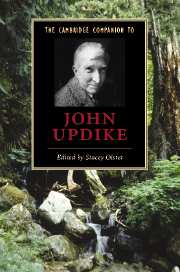Book contents
- Frontmatter
- Introduction: “A sort of helplessly 50’s guy”
- Part I Early influences and recurrent concerns
- Part II Controversy and difference
- Part III American chronicles
- 7 Updike, American history, and historical methodology
- 8 Updike, Hawthorne, and American literary history
- 9 Updike, film, and American popular culture
- 10 Updike, Rabbit, and the myth of American exceptionalism
- Conclusion: U(pdike) & P(ostmodernism)
- Select bibliography
- Index
7 - Updike, American history, and historical methodology
from Part III - American chronicles
Published online by Cambridge University Press: 28 August 2006
- Frontmatter
- Introduction: “A sort of helplessly 50’s guy”
- Part I Early influences and recurrent concerns
- Part II Controversy and difference
- Part III American chronicles
- 7 Updike, American history, and historical methodology
- 8 Updike, Hawthorne, and American literary history
- 9 Updike, film, and American popular culture
- 10 Updike, Rabbit, and the myth of American exceptionalism
- Conclusion: U(pdike) & P(ostmodernism)
- Select bibliography
- Index
Summary
As a young writer, John Updike imagined paying homage to his native state of Pennsylvania with “a tetralogy, of which the first novel would be set in the future, the second in the present, the third in the remembered past, and the fourth in the historical past.” So he began, respectively locating his first three novels - The Poorhouse Fair (1959), Rabbit, Run (1960), and The Centaur (1963) - in the time frames of future, present, and remembered past. Three more novels followed during the next decade, none situated in the historical past. Finally, in 1974, Updike revealed that an uncharacteristic play, Buchanan Dying, was originally meant to be the fourth novel in his youthful tetralogy. It took eighteen more years before he found a compelling way to write historical fiction.
The afterword to Buchanan gives ample evidence that Updike sought out the facts as meticulously as any traditional historian would. He did massive research in a twelve-volume collection of James Buchanan’s writings as well as in dozens of nineteenth- and twentieth-century histories, biographies, articles, and original documents (Buchanan, 183–214). Although he occasionally “touched something live” in his research, he simply could not bring a plot to life (256). Again and again, his efforts to enter into the life of the fifteenth president of the United States were stymied: “[R]esearched details failed to act like remembered ones, they had no palpable medium of the half-remembered in which to swim; my imagination was frozen by the theoretical discoverability of everything” (259).
- Type
- Chapter
- Information
- The Cambridge Companion to John Updike , pp. 107 - 121Publisher: Cambridge University PressPrint publication year: 2006
- 1
- Cited by

